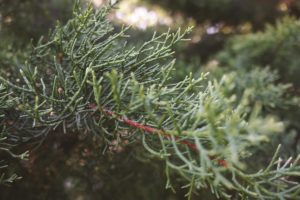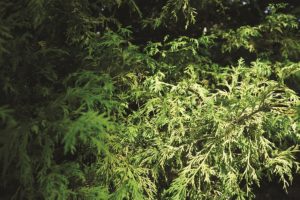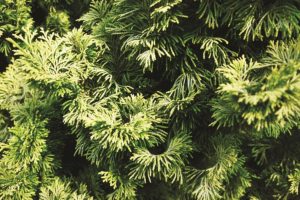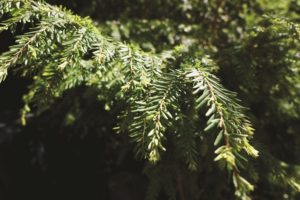Flowers get a lot of attention, and for good reason. They are wondrous, wild, living bursts of color. They are also fleeting, with some blossoms lasting only a day. Deciduous foliage, in all its variety and color, will last six or seven months. Leaves unfurl in early spring and fall to the ground in drifts when the frosts come.

But conifers are lasting. They are an entire world of color, texture, and shape. They are the heart of a year-round garden.
I’ve always felt that conifers are an underused element in Cape Cod gardens. This is understandable — many of our landscapes are designed and planted for the warm season when most of our visitors and summer residents are here to enjoy them. Conifers, though, are not merely evergreens to be seen and appreciated when all else is bare. They have a place in the fullness of summer, too. I am writing about them because they are worth noticing now. They are truly year-round essentials in our landscapes.

Pines, junipers, spruces, redwoods, yews, firs, hemlocks, and cypresses — there are many more conifers to list, and a seemingly infinite array of varieties to explore within these designations. Instead of leaves, their foliage consists of scales and needles, which remain on the plant for multiple years. Instead of flowers, they produce cones as reproductive structures.

One could plant a garden with nothing but conifers and never experience a dull day appreciating it. Do a quick image search for “conifer garden” and prepare to feel your mind expand. The conifer bed is an exercise in the appreciation of subtlety. It speaks the language of color, texture, pattern, and form, and offers a play of shapes, visible in one way up close and differently from afar. We are used to seeing a single conifer, making a statement of its own. But they can be invited into compositions among other independently impressive elements.

The conifer color palette feels endless. Coarse and linear spruces in dusky powder blue. The pendulous, dripping lines of weeping cypress, with shaded interiors that make the vibrant foliage glow. Hinoki false cypress will grow in spiraling “whorls” that could awaken flashbacks; spiders build their webs in their twisting, mottled green-gold tunnels. Hollywood junipers look like something from a Dr. Seuss story, with dense, deep green wisps of foliage. Golden deodar cedars are fairytale trees that produce ephemeral gusts of golden air moving skyward.
Then there are the cones. If you love a good flower, you’ll understand the weird and varied world of these densely layered scales. There are purples and blues and blacks that expand and unfurl as the season progresses.

Conifers are adapted to a wide range of environmental conditions, from full sun to shade. They can thrive in sandy, dry sites or in richer soils. Most of them prefer full sun and soil that drains well. They thrive in those hot, troublesome areas where nothing else wants to grow. There are varieties of cypress, spruce, hemlock, and white pine that will tolerate considerable shade, however. It’s fun to see how these plants express their growth and coloration in varied settings. All the evergreens prefer acidic soils. In all, these species are very well suited to the sandy, naturally acidic soils of the Outer Cape.
As you consider your fall plantings, or on your next trip to the nursery, let yourself venture into the space of the conifers. Bring an open mind and seek the subtlety these plants offer. Theirs is not a single boastful moment. They do not shout. They are quiet, consistent whisperers. Can you hear them?



